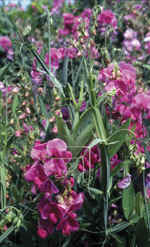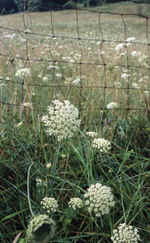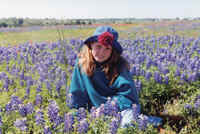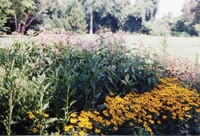Wild
For Wildflowers
Establishing
these flowers in your garden can help to promote balance in nature.
by Paula Steers Brown, Contributing Columnist
The word �meadow� is derived from the Old English
word meaning �to mow.� The first mowers were the animals that cut down
the grasses and wildflowers in pasturelands. Wildflowers are flowers that
grow freely without cultivation � plants that thrive in the existing
conditions of their native habitat. They grow not only in meadows, but also
in wetlands, on the forest floor, on mountains and in deserts. Wildflowers
have enormous ecological value as part of the food web, but their native
habitats have been disappearing with urban development. A new organic
approach can promote a balance in nature. The wild garden can provide
sustenance for beneficial insects and small animals while creating a
soothing aesthetic appeal, but it could not be more different from the
customary landscape of modern hybrid ornamentals showcased for individual
beauty. Wildflower gardening requires us to tap into a connectedness to the
larger landscape much like a Frank Lloyd Wright building does to its
environment.
Transition in the landscape
|

Perennial
Sweet Pea (Lathyrus latifolius) is perfect for covering a
bank in hot sun. Its luscious mauve/rose pea-like blossoms and curly
green tendrils look spectacular cascading from summer baskets. |
Meadows can be used to provide open spaces to attract
birds and small wildlife. If you are lucky enough to live in a rural area
that still affords open vistas beyond your home, a meadow would be a perfect
transition from the groomed landscape to the natural areas beyond. At a
woodland edge, shade-tolerant meadow plants or drifts of native shrubs
create a pleasing visual transition and also provide a practical barrier to
keep seedlings from the woods from popping up in the meadow. Native shrubs
that would make a handsome buffer include substantive, free-flowing shrubs
such as bright-yellow forsythia, showy white bottlebrush buckeye, and
graceful purple-berried Callicarpa. At water�s edge, use meadow species
that are moisture lovers. Forget-me-nots, common cattail, swamp milkweed,
Physostegia, monarda, turtlehead, and Joe Pye �weed� are all attractive
choices for moist areas. And by the way, the �weed� attitude must be
relaxed. As Emerson says, �A weed is a plant whose virtues have not yet
been discovered.� Controls must be placed on invasive species that can
harm the environment, but many beneficial innocent plants are misunderstood
such as butterfly weed, which attracts the Monarch butterfly in droves.
Roadside, city, and suburb
|

Few
sights are prettier than the shining gold of a field of wild mustard
(Brassica kaber), but it can present agricultural headaches
if it invades fields of corn, cotton or soybeans. |
From rural roadsides to urban industrial areas, for
example, near railroad tracks, it is not uncommon to see brightly colored
wildflowers clamoring over banks of dry, rocky areas that hardly seem as if
they could support life. One of the advantages of planting wildflowers is
that they can grow under adverse conditions in poor soil and can withstand
drought. In fact, in soil that is too fertile, wildflowers may languish by
either growing tall, spindly stems or by growing foliage that is too lush
with few blooms. Although it might seem unthinkable to the conscientious
gardener who has, for years, been adding humus to the soil, a meadow might
actually thrive if some of the topsoil is removed (to another cultivated
part of the garden) and the remaining topsoil is mixed with a layer of
subsoil to reduce fertility.
|

Queen
Anne's lace (Daucus carota) is difficult to transplant,
but grows readily from seeds. They attract the most beneficial of
all garden creatures, the pollinators, such as bees. |
Drought tolerance is one reason
wildflowers began being planted by highway departments. Lady Bird
Johnson started such ecological programs in the 1960s during the �Keep
America Beautiful� campaign, first in her native Texas now covered with
fields of bluebonnets and red Indian Paintbrush. Successful plantings of
red, pink, and white cosmos frequently dot median strips in Virginia today.
Hardiness also recommends wildflowers to urban conditions. What could be
more of an unexpected treat than an oasis of a small meadow in the city?
Wild gardens are being experimented with more and more, especially in areas
where water is scarce, as a lawn substitute. Native sod-forming grasses are
low-maintenance, drought-tolerant substitutes for the traditional lawn. In
recent summers where drought conditions prevailed and water was rationed,
these cultivars seemed destined for popularity, especially with the converts
to EC � environmental correctness.
Develop your own meadow
|

Fields
of bluebonnets dot the landscape in Texas. |
In planning your meadow garden, remember that the
naturalized area should only be as large as you can control; you must be
able to prevent aggressive plants from taking over and to prevent the
invasion of woody species that would become a bramble patch. A field 100 x
200 ft., (2,000 sq. ft.) can be taken care of by one person with
approximately one-half hour of weeding per week during the active growing
season and a final mowing at the end. Grow native plants in situations that
most closely resemble their natural habitat; plant species that naturally
occur together in a community and support each other. Know your area�s
soil type and pH, level of sunlight, temperature ranges, and amount of
moisture, and choose plants accordingly. Rototill the area 6-8 inches. After
three weeks, spray with an herbicide such as Roundup. Rake and wait two
weeks to plant. Scatter seed, mixed evenly with damp sand or sawdust. Tamp
by gently walking on the area. Mulch lightly with weed-free straw or pine
tags and water until
|

Showy
Joe Pye and blackeyed Susans provide a variety of height and color. |
established. Sow annuals to ensure bloom the first
year, but include biennials and perennials for subsequent displays. In sunny
areas, include grasses to fill in gaps. They serve as a foil for colorful
flowers, create a feeling of openness, and help to bind the soil. Switch
grass, sheep fescue, and broomsedge are good choices for a meadow. Include a
meandering path (even if it is just a mowed strip in a pleasing curve). A
bench or a fence can also show neighbors that your space has been carefully
planned and is not just a case of forgetting to mow. Educate lawmakers about
conservation in areas where zoning restrictions might limit the height of a
grassy area, and involve children in becoming stewards of the environment.
� Paula Brown is a freelance writer and
lecturer on gardening topics. She lives in Richmond, Virginia, where she
runs her design business, Imagine That. Questions, comments? E-mail her at [email protected].
Suggested plants for a Virginia
meadow
Grape hyacinth, Coreopsis lanceolata, blue cornflower
or bachelor�s button (Centaurea cyanus), oxeye daisy (Chrysanthemum
leucanthemum), blackeyed Susan (Rudbeckia hirta), Joe Pye and hardy blue
ageratum (both forms of Eupatorium), purple coneflower (Echinacea), Queen
Anne�s lace, goldenrod (Solidago canadensis), yarrow (Achillea), butterfly
weed (Asclepias tuberosa), tansy, cosmos, and Dame�s rocket
Wildflowers for semi-shade
Spiderwort (Tradescantia virginiana), ajuga reptans,
blue-eyed grass
Wildflowers for woodlands
Mayapples, wild geranium, Virginia bluebells, nodding
trillium, blue phlox, Soloman�s seal, Jack-in-the-pulpit, periwinkle, and
Jacob�s ladder